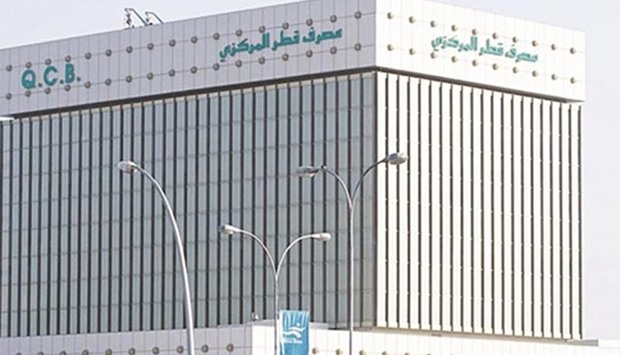Qatar Central Bank (QCB) is expected to maintain its policy rate at 4.5% for most of 2016 to support lending amid economic growth slowing down, says a senior economist analysing Qatar.
“Facing increasing pressures on the riyal, the Qatar Central Bank will nevertheless hike rates by 25 basis points before the end of the year to converge with rising US rates,” points out Olivier Najar, Country Risk analyst (MENA) at BMI Research.
“But the rapidity at which it does so will depend on the pace of the US Federal Reserve 's hiking,” Najar said in an interview with Gulf Times.
BMI Research, a Fitch Group company, expects QCB to continue delaying its convergence with the Fed's hiking cycle for most of 2016 to support lending amid a slowdown in economic growth.
By the end of the year, it forecasts the Qatari Overnight Lending Rate - the main mechanism used by the QCB to send signals to the market - to reach 4.75%, marking a 25 basis points (bps) increase from 2015.
This will compare to a 50bps increase in the US Federal Reserve Funds Rate, which BMI believes will reach 0.75% by end-2016. The “QCB will be able to maintain interest rates stable without worrying extensively about inflationary pressures”, which BMI forecasts will average 2.9% over 2016.
In March, annual inflation stood at just 3.3%, even as the impact of subsidy cuts started feeding through to transport prices.
“Doha is looking to reform its subsidy system and liberalise prices for utilities and fuel, while restraining the public sector wage bill and placing renewed emphasis on the private sector,” BMI said.
In contrast to previous years, supply-demand dynamics in the retail housing market will begin to loosen, as the slump in global energy prices and a greater supply of residential units start to pull prices downward over the coming quarters.
Combined with the continuing strength of the dollar - to which the Qatari riyal is pegged - this will ensure that inflation remains moderate over 2016.
Similar as to other GCC lending institutions, Qatari banks are facing a sharp tightening in liquidity and the QCB will delay rising rates as long as possible in order not to squeeze liquidity further.
The three-month Qatari Interbank Offered Rate (QIBOR) reached 1.5% in May, its highest level since the global financial crisis.
In an effort to ease the strains on the banking system, BMI expects the QCB to reduce the required reserve ratio (which has been fixed at 4.75% of total deposits since 2008), and accelerate steps to borrow more money overseas through international loans. Given its very large financial buffers, the QCB will be able to delay marching in the Fed's footsteps, albeit temporarily. With its $290bn of foreign reserves (including the $256bn of the Qatari Investment Authority) and limited financing needs over the coming years, Doha possesses significant financial buffers, which enable it to defend the peg while delaying policy rate convergence with the US. However, following release of the hawkish Fed minutes on May 18, the chances of a June rate hike in the US have risen substantially, supporting BMI’s view that two more hikes will be seen in 2016.
With the US pushing ahead with its hiking cycle over the coming quarters, we believe that the QCB will eventually have to follow suit it if wants to prevent rapidly rising speculative pressures on the riyal,” BMI said.
Asked what the impact, if any, of a possible QCB rate hike on the national economy, Najar said, “The limited rate hike that we expect the QCB to carry out by end- 2016, will not in itself prevent the Qatari economy to pick up. Put differently, had the QCB been able to loosen monetary policy; this would not have significantly boosted economic activity, given that business confidence would have remained depressed amid low oil prices.”
Najar said he believes “it will take at least a couple of years” for Qatari banks to see some improvements in liquidity.
“Through to 2018 at least, the sector will suffer from slowing deposit growth, rising interbank lending costs, and minor deteriorations in asset quality. In addition, increased competitions for deposits could affect margins. As a result, we believe that Qatari banks will increasingly look abroad to raise funds,” Najar told Gulf Times.
“But the rapidity at which it does so will depend on the pace of the US Federal Reserve 's hiking,” Najar said in an interview with Gulf Times.
BMI Research, a Fitch Group company, expects QCB to continue delaying its convergence with the Fed's hiking cycle for most of 2016 to support lending amid a slowdown in economic growth.
By the end of the year, it forecasts the Qatari Overnight Lending Rate - the main mechanism used by the QCB to send signals to the market - to reach 4.75%, marking a 25 basis points (bps) increase from 2015.
This will compare to a 50bps increase in the US Federal Reserve Funds Rate, which BMI believes will reach 0.75% by end-2016. The “QCB will be able to maintain interest rates stable without worrying extensively about inflationary pressures”, which BMI forecasts will average 2.9% over 2016.
In March, annual inflation stood at just 3.3%, even as the impact of subsidy cuts started feeding through to transport prices.
“Doha is looking to reform its subsidy system and liberalise prices for utilities and fuel, while restraining the public sector wage bill and placing renewed emphasis on the private sector,” BMI said.
In contrast to previous years, supply-demand dynamics in the retail housing market will begin to loosen, as the slump in global energy prices and a greater supply of residential units start to pull prices downward over the coming quarters.
Combined with the continuing strength of the dollar - to which the Qatari riyal is pegged - this will ensure that inflation remains moderate over 2016.
Similar as to other GCC lending institutions, Qatari banks are facing a sharp tightening in liquidity and the QCB will delay rising rates as long as possible in order not to squeeze liquidity further.
The three-month Qatari Interbank Offered Rate (QIBOR) reached 1.5% in May, its highest level since the global financial crisis.
In an effort to ease the strains on the banking system, BMI expects the QCB to reduce the required reserve ratio (which has been fixed at 4.75% of total deposits since 2008), and accelerate steps to borrow more money overseas through international loans. Given its very large financial buffers, the QCB will be able to delay marching in the Fed's footsteps, albeit temporarily. With its $290bn of foreign reserves (including the $256bn of the Qatari Investment Authority) and limited financing needs over the coming years, Doha possesses significant financial buffers, which enable it to defend the peg while delaying policy rate convergence with the US. However, following release of the hawkish Fed minutes on May 18, the chances of a June rate hike in the US have risen substantially, supporting BMI’s view that two more hikes will be seen in 2016.
With the US pushing ahead with its hiking cycle over the coming quarters, we believe that the QCB will eventually have to follow suit it if wants to prevent rapidly rising speculative pressures on the riyal,” BMI said.
Asked what the impact, if any, of a possible QCB rate hike on the national economy, Najar said, “The limited rate hike that we expect the QCB to carry out by end- 2016, will not in itself prevent the Qatari economy to pick up. Put differently, had the QCB been able to loosen monetary policy; this would not have significantly boosted economic activity, given that business confidence would have remained depressed amid low oil prices.”
Najar said he believes “it will take at least a couple of years” for Qatari banks to see some improvements in liquidity.
“Through to 2018 at least, the sector will suffer from slowing deposit growth, rising interbank lending costs, and minor deteriorations in asset quality. In addition, increased competitions for deposits could affect margins. As a result, we believe that Qatari banks will increasingly look abroad to raise funds,” Najar told Gulf Times.



